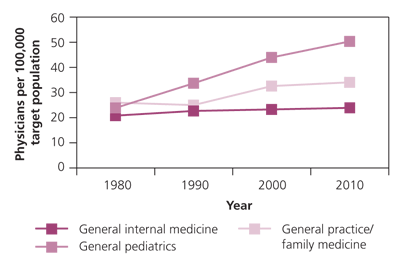
Am Fam Physician. 2013;88(7):online
Author disclosure: No relevant financial affiliations.
Nested within a 40-year trend of specialty-to-population growth outpacing that of primary care is variability in the rate of expansion within the different primary care disciplines.1 With continued population aging trends, low annual birth rate, and expected health insurance expansion, it is vital that physician workforce policy be aimed at meeting population needs to deliver optimal primary care.
Family medicine, general internal medicine, and general pediatrics comprise the majority of the primary care physician workforce in the United States. To better understand trends in the primary care physician workforce, we have examined the growth of family physicians, general pediatricians, and general internists providing direct patient care (see accompanying figure).

The physician-to-population ratio among all primary care physicians has increased consistently for at least the past three decades. The family medicine and general internal medicine physician-to-target population ratios have shown small incremental growth, whereas the general pediatrician-to-target population ratio has increased more and at a steeper rate. The aging population, declining medical student interest in primary care,2 and increased interest in hospitalist careers3 portend a likely crisis for the adult primary care workforce to provide accessible, comprehensive care to those in need. The increase in general pediatricians has greatly outpaced a declining annual birth rate with a continued need for pediatric subspecialists.4 Insurance expansion under the Affordable Care Act will cover several million more children, but also will cover millions more adults—many with pent-up demands for care, and most located in underserved areas.
Primary care workforce need projections are more complex than ever, with smaller patient panel sizes reflective of medical home tenets, increasing part-time work, and career shifts away from full-time direct patient care.5 Policy efforts directed toward further characterization of the unique, individual contributions of the primary care specialties to the delivery of optimal primary care, coupled with the alignment of appropriate workforce production, could help improve access to primary care for millions of patients in the United States.
